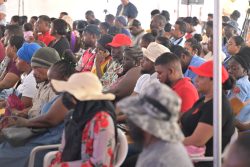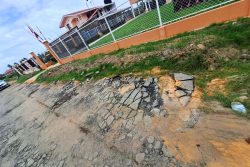Think design – life design: I could design my life the way an architect designs a building, for aesthetic beauty, for creative flair, to be a human being of value, living to transform my world into a just social space. Life is a space that is shapeable.
 I could design my life so that my presence anywhere transforms the social space into a garden of fruitful living. Instead of wasting my days just reacting to life’s challenges and problems, I could be creative and design solutions that work well for everyone in my world.
I could design my life so that my presence anywhere transforms the social space into a garden of fruitful living. Instead of wasting my days just reacting to life’s challenges and problems, I could be creative and design solutions that work well for everyone in my world.
This concept of design thinking solves big problems. It is ground-breaking.
Every morning I wake up with one focus on my mind: how could I design the day ahead to be the best it could be for me, and for people in my social circle? I see my life, lived day by day, as a blank page that I could fill with whatever I want, within the confines of geographic space and finite time.
The work of Edward de Bono on design thinking, outlined in his book ‘New Thinking For The New Millennium’ in the year 2000, has transformed how we tackle problems. This approach to starting my day has become a natural habit. I think design: life design.
Design thinking now shapes every area of planning around the world in developed countries – education, politics, health care. de Bono’s work is transforming how we look at society, and how we tackle problems and challenges. Governments, multinational corporations and individuals employ design thinking to solve crushing problems.
In Guyana, design thinking could fuel creative solutions to overcome the serious problems that keep this society ranking with Haiti in poverty and backwardness. Haiti has the excuse of natural disasters. Guyana’s excuse is?
In every global economic ranking, Guyana falls among the world’s poorest, especially in the Human Development Index of the United Nations.
On the street, people tend to blame the government for the society’s shocking social status in the world. Yet, designing this country is not only government’s role. Corporations, individuals and non-government organizations play key roles, too.
We can look at four people who made giant progress in Guyana to re-design the social landscape, independent of government: Peter D‘Aguiar built Banks DIH into a national icon, with Demico defining the main public square in Georgetown; Yesu Persaud transformed the private sector through his work at Demerara Distillers and in banking; Jocelyn Dow did wonders in civil society with Red Thread; and David de Caires opened up this society to a strong democratic culture through Stabroek News.
This shows that one person could design a solution that ripples across the society. Our generation must learn from these heroes of our land. Their accomplishments are astonishing. They saw the social space as shapeable, not fixed into a set pattern.
Most Guyanese who go to live overseas re-invent their lives. They achieve amazing heights. They aim high and live with great ambition, and so the diaspora has among its population a large body of world leading figures. This land ought to stand tall and applaud the many Guyanese who have achieved great things in this world.
Yet, in the homeland itself, life for even the most elite among us is drudgery, a daily grind to overcome aberrations and deformities in the social landscape.
A nation is a social space. And space has to be designed.
Pick any area of life, and you could employ design thinking to create that area into a space that works, instead of a space that falls apart. We use these metaphors because of the truth in them – areas of life refer to space. Social space defines people instead of physical geography, and so on. The concept of society is a socio-cultural space.
If we think of life as a collection of spaces, and apply design thinking, we can choose any area – personal finance, relationships, business, government, dealing with the deranged and insane on the streets, our health – both personal and national, our politics and the role of Parliament, and we could shape these into workable areas that build the society into a social structure that works for everyone.
Guyana suffers most glaringly from a lack of maintenance. Physical space breaks down everywhere – we can’t even keep the big Stabroek Market clock working. The physical space reflects the psychological space of the people. People feel battered on the streets. They look at Guyana and see insane, deranged people occupy the sidewalk of their Parliament.
Design thinking could transform the psychological, emotional space of the people in this land, and this would ripple across to transform the physical space into a land of aesthetic wonder. With design thinking, we could bring back our Garden City as a natural wonder of the 21st century world.
Let’s apply design thinking to two areas of the social space of Guyana, those public places that define who we are as a people.
First, the minibus culture. Former President, the late Desmond Hoyte, re-defined the social space of Guyana when he scrapped the state’s transport system in the 1980’s and allowed private enterprise to define the public transport system. Through a series of concessions, this private system settled on cheap re-conditioned Japanese mini-buses. The design solved the transportation problem that crippled the land in in the 1980’s. But the system’s design also built a culture that doesn’t work for the social space. In design thinking, we have to consider the total effect.
While the minibus culture solved the transportation problem, it created a whole sub-culture of workers known as minibus drivers and conductors, many of whom are school dropouts. The minibus culture allows a whole national industry to exist without need for any literacy. The system has no training programme for minibus drivers. The system has no structure to train conductors to be mannerly, polite and conduits to a tourism society. The system fuels a sub-class of crass, cussing conductors who wave bundles of money in the face of passengers and pack the minibuses to choking capacity. And then the driver blasts his music and speeds like a maniac. And bribes police with big bragging.
All over this land, this is the scene confronting people. A generation growing up in it learns to imitate it, and to take it as the norm. The minibus culture is a transport structure that desperately needs re-design, starting with designing the human resource quality of the industry.
The concept of design thinking applies, however, to individual lives as well. We must each of us commit to design our personal life in such a way that we become human beings of quality, noble living and agents for community transformation. Like Ian McDonald urges so often, reading literature works wonders for designing the personal life.
This brings us to a second area where design thinking could work wonders to re-shape the social landscape of Guyana: the national media.
The government loves to boast that it fosters democracy in Guyana. President Bharrat Jagdeo made democracy a key point of his talks at the recent South American Union summit. (I refuse to use the acronym UNASUR because acronyms mess up the design of a body of text).
Have we designed a democratic society since 1992?
Democracy does not only comprise free and fair elections. Democracy is a social structure that stands on the vital pillars of free and fair elections, an educated, informed electorate and a media with ready access to state officials and information. The government must be accountable to a free, independent professional media.
The media in Guyana seem shuttered out of the process of governance. The government seems to see the free, independent media as antagonistic and hostile to it. Yet, the media’s job is a watchdog role in a democratic structure. The media’s role is to point out a pothole on a road, not praise the government for having a road.
So we need to look at Guyana being a democratic society, and ask if we have designed a society that is truly democratic, or only democratic for a segment of the society, while alienating a large section.
If we approach our society from the perspective of design thinking, looking at every area of the structure of Guyana and ask ‘how can we best design workable socio-psychological structures for the social space to be pleasing to every person occupying it’, then we could see rapid transformation of the Guyana landscape, and the creative potential of the people would blossom to astonishing results.
Let’s think design – life design, with a goal of transforming the social spaces of this land.









